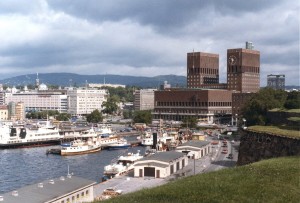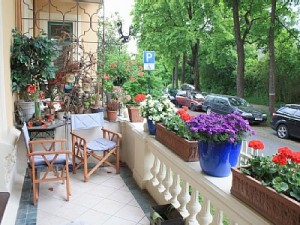This article is written by Parmanu, an Indian writer based in Germany
Since a week and a half I’ve been wrestling with the Oslo piece. The word processor tells me I have three thousand words; I think most of it is rubbish. An image from a nameless movie takes shape: a man is slumped over his desk, in front of a typewriter; crumpled pages are littered on the floor. That image carries a certain weight: physical traces of work done, of time spent. I do not have even that.
My first problem is with photographs of our trip. I cannot get them out of my head. The photographs bend the narrative around themselves, like gravity bends light, and soon they take over the narrative, making me write this or that episode about an image. I’ve had enough. I want to float free of gravity. Forget the photographs – there aren’t any in this piece. If you’re looking for an easy impression of Oslo, go elsewhere: Google some pictures, or visit Flickr.
 My second difficulty is with tone. I do not know who is telling the story. Is it a tourist? A wanderer? A traveler? A historian? An academic? An observer? An enquirer? A poet? An adventurer? The choice – or choices – here will determine the tone, and influence the voice. Don’t be dismissive, this isn’t a small matter: your impression of Oslo depends on this choice. The tourist, you see, is superficial. The wanderer digs deeper, but is selective. The traveller is more holistic, comprehensive. The historian delves into the past. The academic spells out theories. The observer gives you details without judgement. The enquirer probes, analyses, passes judgement. The poet, purely instinctive, relies on images. The adventurer does, then speaks.
My second difficulty is with tone. I do not know who is telling the story. Is it a tourist? A wanderer? A traveler? A historian? An academic? An observer? An enquirer? A poet? An adventurer? The choice – or choices – here will determine the tone, and influence the voice. Don’t be dismissive, this isn’t a small matter: your impression of Oslo depends on this choice. The tourist, you see, is superficial. The wanderer digs deeper, but is selective. The traveller is more holistic, comprehensive. The historian delves into the past. The academic spells out theories. The observer gives you details without judgement. The enquirer probes, analyses, passes judgement. The poet, purely instinctive, relies on images. The adventurer does, then speaks.
 How do I get out of this mess? I could set aside these fancy tone-related notions and begin, for instance, with a simple description. I’m sitting in the balcony of our holiday-apartment in Oslo. The balcony faces south, and the morning sun on my cheeks makes the cold bearable. I can hear, over the rumble of some nearby motors, seagulls cawing. To my right is a small canal and a tree-lined path that runs along it. Occasionally a jogger passes by. Beyond our block are other plain-looking apartments and commercial buildings, about seven or eight storeys high. Two cranes, with long brick-red tentacles, signal ongoing development and re-development. In the distance, beyond the box-like structures with aluminium chimneys sticking out like cake-candles, a small hill rises gently from the east and tapers steeply to the west. I can see settlements – apartment blocks, clusters of single cottages – in the eastern side of the hill, and the west is covered with a dense foliage of pines.
How do I get out of this mess? I could set aside these fancy tone-related notions and begin, for instance, with a simple description. I’m sitting in the balcony of our holiday-apartment in Oslo. The balcony faces south, and the morning sun on my cheeks makes the cold bearable. I can hear, over the rumble of some nearby motors, seagulls cawing. To my right is a small canal and a tree-lined path that runs along it. Occasionally a jogger passes by. Beyond our block are other plain-looking apartments and commercial buildings, about seven or eight storeys high. Two cranes, with long brick-red tentacles, signal ongoing development and re-development. In the distance, beyond the box-like structures with aluminium chimneys sticking out like cake-candles, a small hill rises gently from the east and tapers steeply to the west. I can see settlements – apartment blocks, clusters of single cottages – in the eastern side of the hill, and the west is covered with a dense foliage of pines.